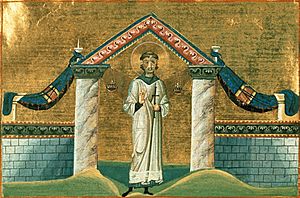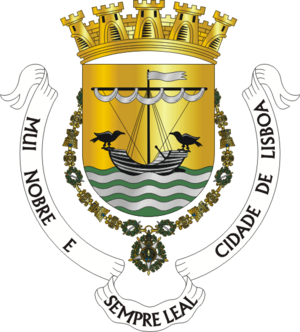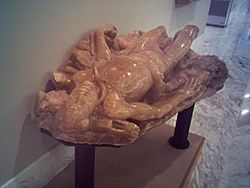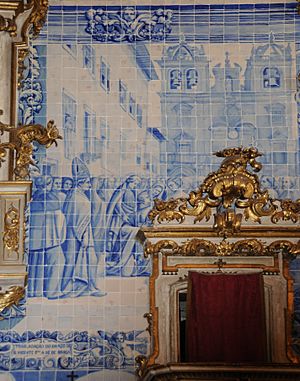Vincent of Saragossa facts for kids
Quick facts for kids SaintVincent of Saragossa |
|
|---|---|
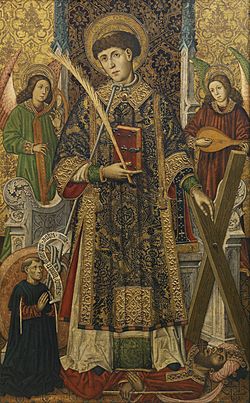
15th-century painting of Vincent by Tomás Giner.
|
|
| Protomartyr of Spain | |
| Born | 3rd century Osca, Hispania Tarraconensis (now Huesca, Aragon, Spain) |
| Died | c. 304 Valentia, Hispania Tarraconensis (now Valencia, Spain) |
| Venerated in | Catholic Church Anglican Communion Orthodox Church |
| Canonized | Pre-Congregation |
| Feast | 22 January (Catholic, Orthodox & Anglican Churches) 11 November (Orthodox Church additional feast day) |
| Attributes | Vested as a deacon, tools of martyrdom and so forth |
| Patronage | São Vicente, Lisbon; Algarve; Valencia; Vicenza, Italy, vignerons (wine-makers), vintners (wine-merchants), vinegar-makers; Order of Deacons of the Catholic Diocese of Bergamo (Italy). |
Saint Vincent of Saragossa (also known as Vincent the Martyr or Vincent the Deacon) was an early Christian saint. He is known as the first martyr of Spain. A martyr is someone who dies for their beliefs. Vincent was a deacon, which is a church helper, in the city of Saragossa.
He is a special patron saint for the cities of Lisbon and Valencia. People celebrate his feast day on January 22 in the Catholic Church, Anglican Communion, and Orthodox Church. The Orthodox Church also remembers him on November 11. Vincent was born in Huesca, Spain, and died around the year 304. This was during a time when Christians were persecuted by the Roman Emperor Diocletian.
Contents
The Story of Saint Vincent
The earliest stories about Vincent's life and death come from a poem. It was written by a poet named Prudentius in the 4th century. He wrote about many Christian martyrs from Spain and Rome.
Early Life and Role
Vincent was born in Huesca, near Saragossa, Spain. This was in the late 200s. He spent most of his life in Saragossa. There, he received his education and became a deacon. A deacon helps the bishop and serves the church.
Bishop Valerius of Saragossa made Vincent a deacon. He asked Vincent to preach throughout the area. Bishop Valerius had trouble speaking clearly. So, Vincent often spoke for him.
Facing Persecution
The Roman Emperor Diocletian started to persecute Christians. This meant he punished them for their faith. Vincent and Bishop Valerius were arrested in Valencia. They were brought before the Roman governor, Dacian.
They were put in prison in Valencia. Vincent was offered freedom if he would burn Christian scriptures. He refused to do this. Vincent spoke for himself and his bishop. He told the judge they were ready to suffer for their faith. He said they would not be scared by threats or promises.
Vincent's Bravery and Death
Governor Dacian became very angry at Vincent's words. He ordered many painful tortures for Vincent. Vincent was stretched on a rack. His skin was torn with iron hooks. Then, salt was rubbed into his wounds. He was even burned alive on a hot metal grill.
Finally, he was thrown back into prison. He was laid on a floor covered with broken pottery pieces. Despite all this pain, Vincent remained calm and peaceful. This amazed his jailer. The jailer was so moved that he changed his ways and became a Christian. Vincent died in prison from his injuries.
After his death, Vincent's body was put in a sack and thrown into the sea. But Christians later found his body. People immediately began to honor him as a saint. Bishop Valerius, who was older, was sent away to live in exile.
The Legend of the Ravens
A famous legend says that after Vincent died, ravens protected his body. They kept vultures from eating it. This allowed his followers to find and recover his body. His body was taken to a place now called Cape St. Vincent in Portugal. A shrine was built there. Ravens continued to guard his grave.
When Muslims ruled parts of Spain, an Arab writer noted these guarding ravens. He called the place "Church of the Raven." Later, in 1173, King Afonso I of Portugal moved Vincent's body. It was brought by ship to the Lisbon Cathedral. This event is shown on the coat of arms of Lisbon.
Honoring Saint Vincent
Vincent's tomb in Valencia became an important place for people to honor him. His fame spread from Saragossa. The city of Oviedo in Spain grew around a church dedicated to him.
Churches and Relics
A church was built for Vincent by Catholic bishops in Spain. This was after King Reccared became a Christian. When the Moors arrived in 711, the church was destroyed. Its materials were used to build the Great Mosque of Cordova.
Today, Vincent's left arm is kept as a relic in Valencia Cathedral. It is a special object that people visit.
Places Named After Him
Many places around the world are named after Saint Vincent.
- The Cape Verde island of São Vicente was named for him. It was discovered on his feast day in 1462.
- The Caribbean island of St. Vincent was named by Christopher Columbus. He found it on January 22, Saint Vincent's feast day.
- There is also the town of São Vicente on the island of Madeira.
- The city of São Vicente, São Paulo in Brazil is also named after him.
Who Saint Vincent Helps
Saint Vincent is the patron saint of many groups and places. He is honored in Valencia, Saragossa, and Portugal. He is also called upon by:
- Winemakers (people who make wine)
- Vintners (people who sell wine)
- Vinegar-makers
- Brickmakers
- Sailors
He is also the patron of deacons in the Catholic Diocese of Bergamo, Italy.
How He is Shown
In art, Saint Vincent of Saragossa is usually shown as a deacon. He wears the special clothing of a deacon called a dalmatic.
See also
 In Spanish: Vicente de Huesca para niños
In Spanish: Vicente de Huesca para niños
- Saint Vincent of Saragossa, patron saint archive


